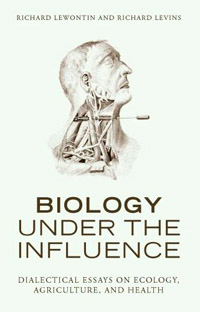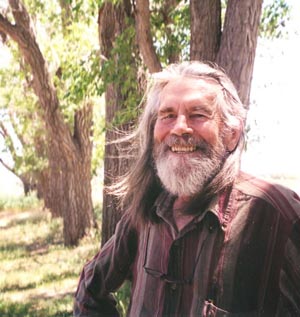 BIOLOGY UNDER THE INFLUENCE: Dialectical Essays on Ecology, Agriculture, and Health by Richard Lewontin and Richard Levins BUY THIS BOOK |
Biology under the Influence: Dialectical Essays on Ecology, Agriculture, and Health by Richard Lewontin and Richard Levins is an exciting book. The title suggests that biology is hampered by narrow theoretical constructs that block interchange between various specialties, as well as that old contempt, “hard science” as superior to “soft science.” Levin and Lewontin blow these away, giving a bright new space for theorizing and for practice.1
As a biologist I once teamed with two mathematicians to teach a course in Systems Theory. We modeled a predator-prey system and a glucose-epinephrine-insulin system. I wish this book had been published at that time. It would have given us, teachers and students both, a helpful jolt, especially because of its wide and bold ranging across disciplines.
Chapter 18 is a fine example of this, extending the glucose-epinephrine-insulin system to embrace anxiety induced at a workplace where the antagonistic pressures of management, an energetic union steward, and individual workers become integral parts of the system.
The book is not only loaded with specific examples from actual research, especially in physiology, genetics, health, and ecology. There is also a chapter relating adventures in Cuba where Levins was a member of a group of scientists urging a drastic shift in agricultural practice, even before the collapse of the Soviet Union.2 This chapter, “How Cuba Is Going Ecological,” is a must read, a detailed account of the struggles, unhampered by profit motives, that brought about the ecological ways of doing agriculture and brought into prominence a situation where scientists can, and often do, work directly with farmers on a basis of equality. It is the most credible writing on Cuban agriculture I have seen. It convinces me all over again that we can, and must, fit our human actions into nature rather than take the sledge hammer approach that results from profit-oriented systems.
On Cuban diversification, the book has this to say about its “mosaic land use that makes better use of topography and microclimates and permits recycling within the farm”:
Each patch of the mosaic has its own products but also contributes to the whole . . . woodlands provide a wide range of forest products and ecological services. Pastures support livestock for meat and dairy products, manure for composting, combat erosion, and serve as vector sources for honey and beneficial wasps. Oxen are integrated with tractors in a complex traction strategy, and horses and other animals are helpful in weed control. Diversification is a hedge against natural disasters. . . .
Biological and natural methods of pest control are proving more effective than chemical control, more economical, and protective of people’s health and the environment. Here’s just one example: sweet potatoes grown using integrated pest management yielded 8.9 metric tons per hectare at a net per hectare value of $904.70 compared to 7.8 tons worth $818.60 per hectare for sweet potatoes grown with conventional methods using pesticides. (p. 362)
A central launching point for this book is that we humans are one species among many and are part and parcel in, and of, earthly processes. Here is a paragraph from the authors’ take on revival of wholism:
But the eclectic theoretical foundations of the new holism is also unsatisfactory. There is an emphasis on the whole that subordinates and even obliterates the parts. The notions of balance, harmony, and stability in the organizing principles of wholes make it difficult to cope with the dynamic aspects of natural processes and with conflict. (p. 128)
The authors warn that current theories, no matter how nice they look, will be modified, sometimes bypassed entirely, as we learn more.
The graceful writing, often nuanced, sometimes blunt, but without pomposity or undefined jargon, advances an understanding of, and enthusiasm for, dialectical ways of thinking and of doing science, thereby bringing science and practice into dynamic contact, cooperation, and mutual respect. A theme of Biology under the Influence is that nature, ourselves included, is a process, evolving, changing. Furthermore, we can expect nature to spring surprises along the way. For that theme alone, I think we all need this book.
1 Richard Lewontin and Richard Levins, Biology under the Influence: Dialectical Essays on Ecology, Agriculture, and Health. Monthly Review Press, 2007. Lewontin is Alexander Agassiz Research Professor at Harvard’s Museum of Comparative Zoology. Levins is John Roch Professor of Population Sciences at Harvard’s Department of Population and Interntional Health.
2 This account of Cuban agriculture, by Richard Levins, first appeared in slightly different form in Capitalism, Nature, Socialism 16, 2005. A host of further references on Cuban agriculture is given in its notes, pages 387-88.

|
| Print
